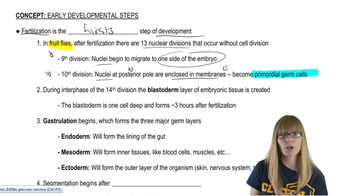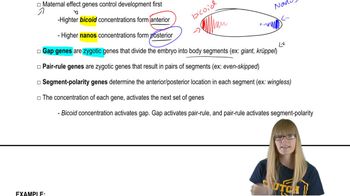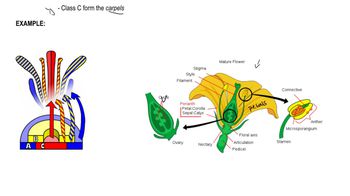Table of contents
- 1. Introduction to Genetics51m
- 2. Mendel's Laws of Inheritance3h 37m
- 3. Extensions to Mendelian Inheritance2h 41m
- 4. Genetic Mapping and Linkage2h 28m
- 5. Genetics of Bacteria and Viruses1h 21m
- 6. Chromosomal Variation1h 48m
- 7. DNA and Chromosome Structure56m
- 8. DNA Replication1h 10m
- 9. Mitosis and Meiosis1h 34m
- 10. Transcription1h 0m
- 11. Translation58m
- 12. Gene Regulation in Prokaryotes1h 19m
- 13. Gene Regulation in Eukaryotes44m
- 14. Genetic Control of Development44m
- 15. Genomes and Genomics1h 50m
- 16. Transposable Elements47m
- 17. Mutation, Repair, and Recombination1h 6m
- 18. Molecular Genetic Tools19m
- 19. Cancer Genetics29m
- 20. Quantitative Genetics1h 26m
- 21. Population Genetics50m
- 22. Evolutionary Genetics29m
14. Genetic Control of Development
Developmental Patterning Genes
Problem 9
Textbook Question
Actinomycin D is a drug that inhibits the activity of RNA polymerase II. In the presence of actinomycin D, early development in many vertebrate species, such as frogs, can proceed past the formation of a blastula, a hollow ball of cells that forms after early cleavage divisions, but development ceases before gastrulation (the stage at which cell layers are established). What does this tell you about maternal versus zygotic gene activity in early frog development?
 Verified step by step guidance
Verified step by step guidance1
<span>Understand the role of actinomycin D: It inhibits RNA polymerase II, which is responsible for transcribing mRNA from DNA. This means that in the presence of actinomycin D, new mRNA synthesis is blocked.</span>
<span>Consider the stages of early development: In frogs, early development proceeds through cleavage divisions to form a blastula, followed by gastrulation where cell layers are established.</span>
<span>Analyze the effect of actinomycin D on development: Since development can proceed to the blastula stage but not beyond, this suggests that the mRNA required for early development up to the blastula stage is already present in the egg before fertilization.</span>
<span>Differentiate between maternal and zygotic gene activity: Maternal gene activity refers to mRNA and proteins deposited in the egg by the mother, while zygotic gene activity involves the transcription of new mRNA from the zygote's genome.</span>
<span>Conclude the implication: The fact that development stops before gastrulation in the presence of actinomycin D indicates that maternal mRNA supports early development up to the blastula stage, but zygotic gene activity is required for progression beyond this point.</span>
Recommended similar problem, with video answer:
 Verified Solution
Verified SolutionThis video solution was recommended by our tutors as helpful for the problem above
Video duration:
3mPlay a video:
Was this helpful?
Key Concepts
Here are the essential concepts you must grasp in order to answer the question correctly.
RNA Polymerase II Function
RNA polymerase II is an enzyme responsible for transcribing DNA into messenger RNA (mRNA) in eukaryotic cells. This process is crucial for gene expression, as mRNA serves as the template for protein synthesis. Inhibiting RNA polymerase II, as with actinomycin D, disrupts the transcription of zygotic genes, which are essential for later stages of development.
Recommended video:
Maternal vs. Zygotic Gene Activity
In early embryonic development, maternal gene products (mRNAs and proteins) deposited in the egg are utilized before the zygotic genome is activated. Maternal gene activity supports initial development, while zygotic gene activity becomes critical as the embryo transitions to later stages. The ability of embryos to develop past the blastula stage in the presence of actinomycin D indicates reliance on maternal gene products.
Recommended video:
Guided course

Maternal Effect
Gastrulation
Gastrulation is a pivotal phase in embryonic development where the single-layered blastula reorganizes into a multi-layered structure, establishing the three primary germ layers: ectoderm, mesoderm, and endoderm. This process is essential for the proper formation of tissues and organs. The cessation of development before gastrulation in the presence of actinomycin D suggests that zygotic gene expression is necessary for this critical transition.
Recommended video:
Guided course

Drosophilia Development

 11:19m
11:19mWatch next
Master Segmentation Genes with a bite sized video explanation from Kylia Goodner
Start learningRelated Videos
Related Practice




